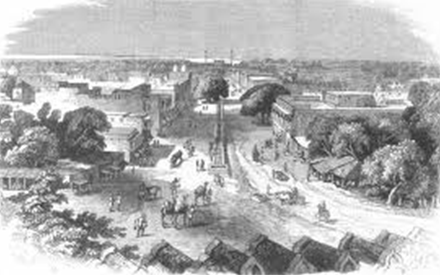Inside The Old City
Colonialism and The Story of the Imperial Capital of Class 8
The excellent system of water supply and drainage built during Mughal rule was neglected in the nineteenth century. The system of wells (or baolis) were broken, and channels to remove household waste (called effluents) were damaged.
This was at a time when the population of the city was continuously growing. At the end of the nineteenth century, the Shahjahani drains were closed and a new system of open surface drains was introduced. This system too did not work to a long time and many of the wealthier inhabitants complained about the stench from roadside privileges and overflowing open drains system.
The Delhi Municipal Committee was unwilling to spent on a good drainage system. At the same time million of rupees were being spent on drainage systems in the New Delhi area.
THE DECLINE OF HAVELIS
- The Mughal aristocracy in the seventeenth and eighteenth centuries lived in grand mansions called haveils. Havelis were large walled compounds with mansions, courtyards and fountains. A haveli housed many families. On entering the haveli through a beautiful gateway an open courtyard, surrounded by public rooms meant for visitors and business, used exclusively by male. The inner courtyard with its pavilions and rooms was meant for the women of the household. Rooms in the havelis had multiple uses, and very little by way of furniture.
- Many of the Mughal Emperors were unable to maintain these large establishments under conditions of British rule. Haveiis therefore began to be subdivided and sold. Often the street front of the havelis became shops or warehouse. Some havelis were taken over by the upcoming mercantile class, but many fell into decay and disuse.
- The colonial bungalow was quite different from the haveli. Meant for one nuclear family, it was a large singlestoreyed structure with a pitched roof, set in one or two acres of open ground. !t had separate living and dining rooms and bedrooms, and a wide veranda running in the front, and sometimes on three sides. Kitchens, stables and servants' quarters were in a separate space from the main house.
THE MUNICIPALITY BEGINS TO PLAN
- The census of 1931 revealed that the Walled city area was horribly crowded with as many as 90 persons per acre, while New Delhi had only about 3 persons per acre.
- In 1888 an extension scheme called the Lahore Gate Improvement Scheme was planned by Robert Clarke for the Walled City residents. The idea was to draw residents away from the Old City to a new type of market square, around which shops would be built. Streets in this redevelopment strictly followed the grid pattern, and were of identical width, size and character. Land was divided into regular areas for the construction of neighbourhood.
- The Delhi Improvement Trust was set up 1936, and it built areas like Daryaganj South for wealthy Indians. Houses were grouped around parks. Within the houses, space was divided according to new rules of privacy. Instead of spaces being shared by many families or groups, now different members of the same family had their own private spaces within the home.










